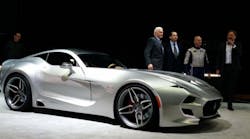Auto Show: Industry Vets Fisker, Lutz Roll Out Two Hot Rods
DETROIT—Two titans of the auto industry -- U.S. executive Bob Lutz and Danish designer Henrik Fisker--have joined forces to build high-end, limited-edition American sports cars.
They launched two supercars--the Force 1 and the Destino--at the Detroit auto show this week with the aim of taking on big names like Ferrari, Maserati and Aston Martin.
They are "the perfect duo of management and financial skills and design innovation to develop a bona fide American supercar," enthused Karl Brauer, an analyst with Kelley Blue Book.
At 83, the silver-haired Lutz has helped write the history of the US auto industry. He's headed product development at Chrysler, Ford, BMW and General Motors, where he became the face of GM's electric ambitions and built the Chevy Volt plug-in hybrid.
At their new company VLF Automotive, Lutz and Fisker are throwing everything into the design to make their cars stand out in the crowded market.
The two models incorporate the most luxurious technologies available. The F1 is equipped with a roaring 745 horsepower, V10 engine while the Destino can charge a more 'modest' 638 horses with a V8 borrowed from the Corvette ZR-1.
The Force 1, at the center of a legal battle between Fisker and his former employer Aston Martin, is made with carbon fiber and inspired by the Dodge Viper, but with a more plush interior.
The four-door Destino has a sculpted, muscular stance and bespoke options, including sitting down with Fisker to decide on the color combinations.
Futuristic design
The vehicles are "very modern, very futuristic" and are designed to be the right balance between a race car and a luxury sports car, Fisker told AFP in an interview at the Detroit auto show.
"The design of this car is about showing the power which I think is typically American."
The effort began with a company Lutz launched in 2012, VL, which generated huge buzz in Detroit with the first version of the Destino.
Fisker's arrival -- which brought the F to VLF -- and his innovative design gave the enterprise much-needed momentum.
Production of the new Destino has already begun in a suburb of Detroit and the Force 1 is scheduled to reach customers later this year.
At 52, Fisker can claim a host of design successes, like the BMW Z8 and the Aston Martin DB9. He's hoping to return to the winner's circle with VLF.
"It's about people making something with passion," he said.
"We think there is room to do something unique, something, when you show up in that car, people will go like, 'what is that?'"
The cars are not cheap. The Force 1 will cost around $300,000 and the Destino $229,000.
"I think there is a market for people who want something unique and exceptional," Brauer said. "I think Force 1 and Destino would sell."
Battle with Aston Martin
One potential stumbling block is a looming legal battle with Aston Martin, which has accused Fisker of copying designs developed at his former employer. It tried to block VLF from showing the Force 1 in Detroit.
"I am not going to let myself get intimidated by unfair threats," said Fisker, who launched a $100 million countersuit.
"I think everybody looking at this car can see this is a Force 1 and nothing else."
Fisker and Lutz both invested $5 million to jumpstart production and VLF has also managed to raise money from outside investors.
"We have a lot of confidence that we will be successful," one investor who wished to remain anonymous told AFP.
"They're shippable, they have buyers already, they have already made investments in design."
Production of the F1 will be initially limited to just 50 vehicles. Production of the Destino could be somewhat higher, but the company only has to sell 100 cars to be profitable, Fisker said.
"We're not going to make billions, but we're not trying to," he said. "We want to be a small company that produces exceptional cars."
Copyright Agence France-Presse, 2016




